So, new year, new me... well, new platform to host my rambling thoughts on anyway!
Ive enjoyed using Blogger, it has a lot to sell it but I needed to spead my wings, consequently I will now be posting on my exciting new fangled website which has a lot more to offer.
I hope that you too will find it a lot more user friendly and continue to enjoy my posts, please do come and join me here...
https://loujnicholls.wordpress.com
Another benefit is I get to show you some of my best photographs of the lovliest plants and in time I'm planning on being able to provide them as lovely little cards. Heres one ive already sent off for printing just waiting to see the results
and if youve been waiting to read Part 2 of the winter garden here it is...
The winter garden-part 2
So thank you Blogger and even more so thank you all you lovely people who have made this part of my journey fun and rewarding. I look forward to hearing from you on my new site!
Forget me not
Adventures in Horticulture!
Monday 16 January 2017
Thursday 29 December 2016
The Winter Garden - Part 1
To any of you who havent stumbled on me before let me take a moment to say Hi & welcome!
I asked Twitter what they would like me to blog about & gave 3 options, this was the one that quite frankly came out streets ahead, which of course is the one I was most dreading writing.
This may sound odd coming from me but the concept of a garden totally skewed towards the winter months was something that until recently hadn't really come up in my radar. Why? I'm not quite sure?
In most of our gardens it would be nigh on impossible to dedicate an entire garden or even section of garden to just plants that look or smell good in the winter. Most urban gardens just don't have the scale needed for this but what we can do if we want to incorporate this into our lives is perhaps take one or two of the choicest plants and use those.
A common misconception with gardens in winter is everything stops, nothing grows, nothing changes and nothing flowers. This simply isn't true. Winter can be an amazing time to be out in the garden and if planned correctly can be full of scent, colour and flowers from December through to the end of February when Spring creeps up on quiet feet.
On a personal level the first time winter gardens came to my attention was whilst working at Sissinghurst. The National Trust introduced its 365 policy (meaning that they wished to open properties for 365 days a year) Many gardens, including Sissinghurst werent geared up to being viewed all year round and there was talk of introducing a whole new section of garden designed specifically to be viewed in the winter. This was a bit of a contentious issue for gardens that are essentially historic in their approach. Obviously the planting styles of the original garden couldn't possibly be overturned, ideas of converting outlying field areas into new gardens were discussed. Whether or not this is happening or whether it will ever happen im not sure but it did raise the idea of a garden completely designed to be viewed in the deepest depths of winter.
I had originally thought to cover this subject in just one post, it soon became obvious that such a large subject deserved more so below I outline some of the aspirational plants for winter in the form of shrubs & trees
Shrubs
Chimonanthus praecox

This is one of my most loved plants for scent, so rarely seen (or noticed) for the most part of the year. My first encounter, that I remember, with this plant was at Hole Park. This unassuming shrub id hardly looked at, hidden up in the woodland amongst a million other shrubs, suddenly leapt out at me with the most gorgeous scent ive ever come across from about 20 foot away! To me it smells exactly like Banana Milkshake, specifically Yazoo Banana Milkshake. I could literally sniff it for hours!
They had 2 at Hole Park, the one in the woodland (which seemed to have more scent?) the other in the Millenium Garden which we found a very old label on whilst pruning it saying "Chimonanthus fragrans". Quite possibly this label had been there since the the shrub had been planted, maybe as far back as the 20's when the gardens were laid out, although most likely closer to the 60's judging by its size. There are now only Chimonanthus praecox, all the rest of the names inc. C. praecox var. Grandiflora are now synonyms. Regardless a rose by any other name etc.

Pretty much bombproof as far as plants go it will take even the hardest of winters and keep flowering. As a native of China its well used to roughing it out amongst the snows despite its delicate appearance. So far as I can ascertain it was first recorded in 1822, like most plants from China around that time planthunters risked life and limb literally to bring them back.
If youd like to know more about the planthunters of this time and region I did come across this lovely article Financial Times - Plant hunting in China This is exactly the sort of thing that excites me immensly! I dream of one day following in the footsteps of these giants... Anyway! back to winter plants!

Cornus
A firm favourite with gardeners, nurseries and designers alike, especially C. sanguinea 'Midwinter fire'. Now don't get me wrong when i say this as I do appreciate why its become so popular but I am getting a bit bored of seeing it. Especially when there are SO many other good Cornus out there!
Just from the C. sanguinea alone there are so many to choose from!

- Cornus sanguinea 'Magic flame'
That said 'Midwinter fire' does have its merits especially when used alongside other impressive varieties. Cornus alba sibirica has several varieties worthy of garden space as does Cornus sericea. Why not mix them up?

- Cornus sanguinea 'Midwinter fire' (Left) with Cornus alba sibirica 'Ruby'
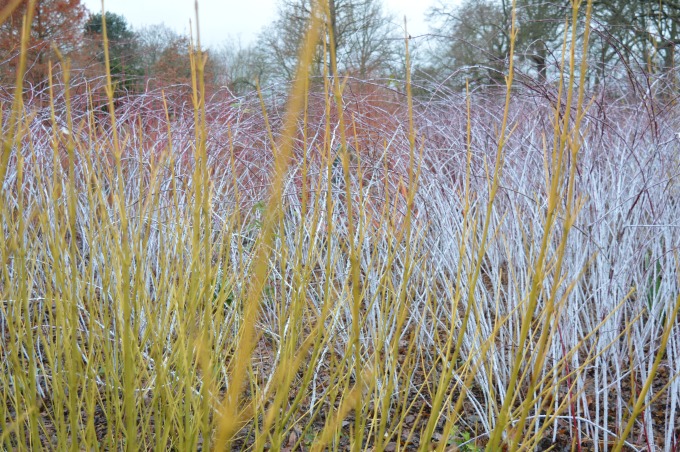
- Cornus sericea 'Buds yellow' in foreground with Rubus biflorus in background
Daphne
A highly under rated plant, in my humble opinion, the Daphne has scent and colour in the form of beautiful delicate flowers. I rarely see them and my parents attempted to grow one years ago in a pot but it eventually succumbed and went to the great compost heap in the sky!

A lot of Daphne's are evergreen but Daphne mezereum holds its flowers on bare branches, flowering on 2nd year wood and slow-growing very little in the way of pruning needs to be done. Maybe that's for the best as it can cause quite a severe skin reaction, hence its common name of Spurge laurel. It's certainly one you would teach your children to approach with caution but then shouldnt they be taught from an early age that every plant in a garden be given respect?

- Daphne bohlua 'Hazel Edwards'
One other Daphne that bears mentioning, which sadly I don't actually have a picture of is Daphne odora, as the name suggests is highly scented. A native of China this time, a short-lived evergreen shrub. Like all Daphnes can be toxic, so be cautious when pruning. It produces the typical pale pink tubular flowers which can be smelt often before they're seen.
Salix
The common willow is often overlooked when thinking of winter colour but its young stems are equal to Cornus and incredibly useful in waterlogged, boggy soils or on the edge of ponds.
Coppiced regularly Salix alba in particular offers a great variety of colour. Vitellina ‘Yelverton’ gives shoots with a beautiful warm reddy orange glow to rival Cornus 'Midwinter fire'. Whilst S. alba ‘Chermesina’has a slightly more pronounced orange glow to it and S. alba ‘Britzensis’ has bright scarlet shoots. Another one worth including on this list is S. daphnoides with the added bonus, for me, that it can be prone to fasciation where its plummy coloured stems become flattened & distorted. Having clambered over a stooled trunk to remove the older shoots about 3 ft out from the edge, trying desperately not to slip and fall into the icy water of the egg pond at Hole Park this holds particularly fond memories for me.

- The fasciated stem of Salix daphnoides

- Salix alba var. Vitellina 'yelverton'
When we hear the name Lonicera we will often automatically think of the Honeysuckle vine that clambers through our woodlands but another Chinese import, this time by Robert Fortune the Scottish planthunter, in 1845 changed the face of our winter gardens. Lonicera fragrantissima, whose most outlandish common name is "Kiss me at the gate" or more commonly "Winter honeysuckle" is a rather unremarkable shrub throughout the other months but come December its gentle, delicately lemony perfume lingers on a still day.
There are several names which are no longer accepted and are only synonyms now, an odd one to this which at present is still classified as unresolved is Lonicera × purpusii.
This was first classified back in 1923 as a cross between L. fragrantissima and L. stadishii ssp. standishii. Given that L. standishii is now a synonym of L. fragrantissima i admit im a little confused by its current unresolved status. All i can think is that at present no one has got around to changing this officially but that it will just end up as a variant like the others.
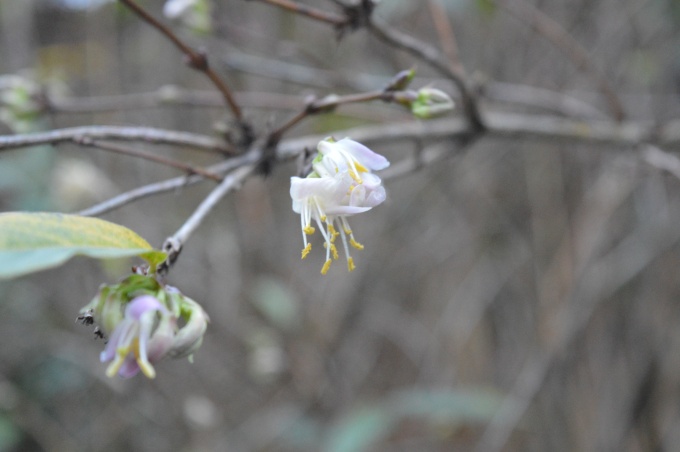
- Lonicera standishii 'Bhudapest' at Wisley is now a synonym Lonicera fragrantissima
Mahonia
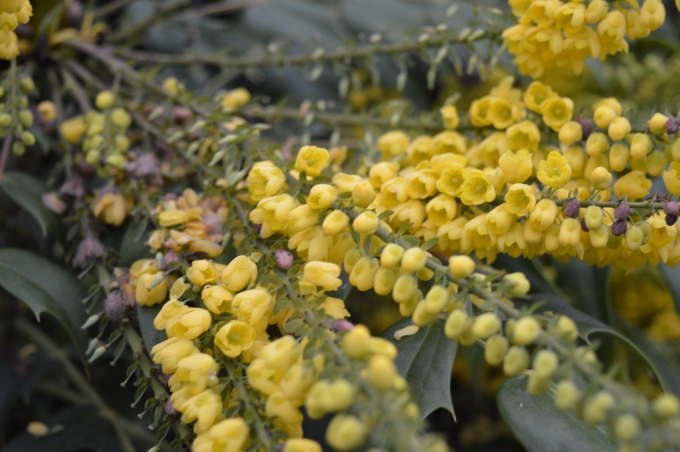
- Flowers of Mahonia aquifolium
Their scent drifts across the garden so strongly it can make you think if you close your eyes you are in fact standing in a garden in midsummer and for the occasional brave bee on a warm winters day an amazing source of nectar.
To make them even more attractive, to my eye, some of them colour up nicely when caught by a little frost and some even have a reddish tint to their new foliage.
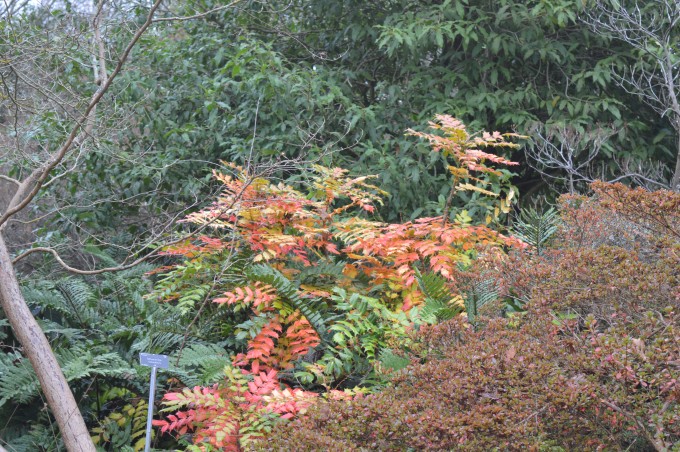
- I think this is Mahonia japonica but couldnt get close enough to read the label!
If you're not sure that your Mahonia is still a Mahonia here's where you can check... The Plant List
This list is a constantly updated version of acceptable names and their synonyms in this harsh, fast moving world of plant name revisions!
That said, im sure no one will shoot you if you continue to call your Mahonia nevinii that and not Berberis nevinii.... except me, I might... maybe...
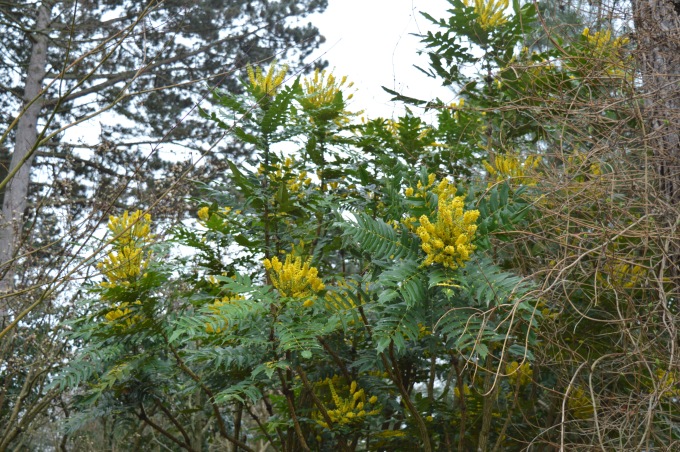
- Mahonia aquifolium

Sarcoccoca confusa is the best known of the Sarcoccoca family, often referred to as Sweet Box or Christmas Box, its thought to originate in western China. Not only can this beautiful evergreen shrub overwhelm you with its intense perfume it has an added bonus of holding its glossy deep purple black berries whilst flowering!
It's slightly shorter cousin S. hookeriana is just as attractive for scent in midwinter.
Viburnum
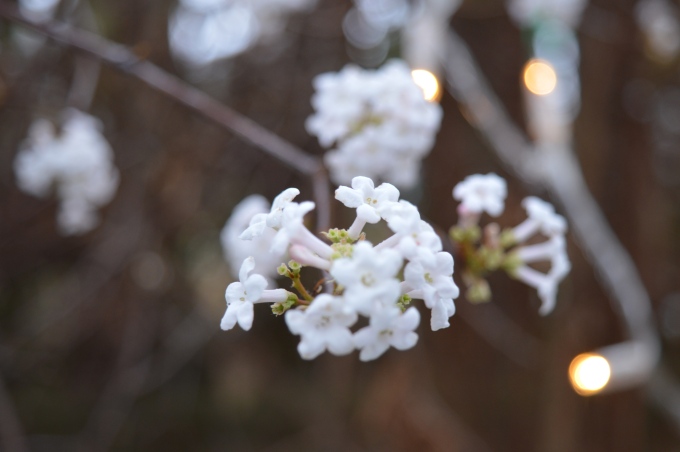
- Viburnum farreri syn V. fragrans. One of the parent plants of V. bodnatense
Viburnum × bodnantense (V. farreri × V. grandiflorum) is a popular choice for gardens. Selected by, Bodnants then Head Gardener, Charles Puddle about 1935 it was in fact bred at Edinburgh Botanic Garden in 1933 *little known fact klaxon*
bodnatense 'Dawn' tends to be the most frequently encountered but there are others 'Charles Lamont' for example. I have to admit that on first appraisal there's not a huge difference between them though. I guess if you're are a real Viburnum fanatic though you will easily spot which one is which.... maybe... possibly...

- Viburnum bodnatense 'Dawn'
The white stemmed bramble of which the most famous, perhaps, is cockburnianus... making horticultural students across the country giggle into their textbooks. That said it's a massive genus with around 700 species, not all suitable for the fix of winter colour we are looking for but 3 stand out above the others
Rubrus cockburnianus
Rubus thibetanus
Rubus biflorus

- Rubus biflorus
Rubus phoenicolasius- Japanese wineberry differs slightly from the others named as its stems are bright red and its one that I would be careful of siting in too small a garden as once established it can be a bit of a thug, worth it for the fruit though!
Trees
Betula pendula - silver birch

- Betula pendula against a midwinter sky at Anglesey Abbey
A good tree for a medium-sized back garden in its natural habitat it would only be found at higher altitudes but is quite happy to put its roots down for us in suburbia. With trees like this it gives us great opportunity to underplant with some of the great ground cover plants ive already talked about but I like it underplanted with Ophiopogon planiscapus 'Nigrescens', often referred to as 'Black grass' it's actually a member of the Asparagaceae family. Mix that with Narcissi 'Rip van winkle' and it looks stunning!
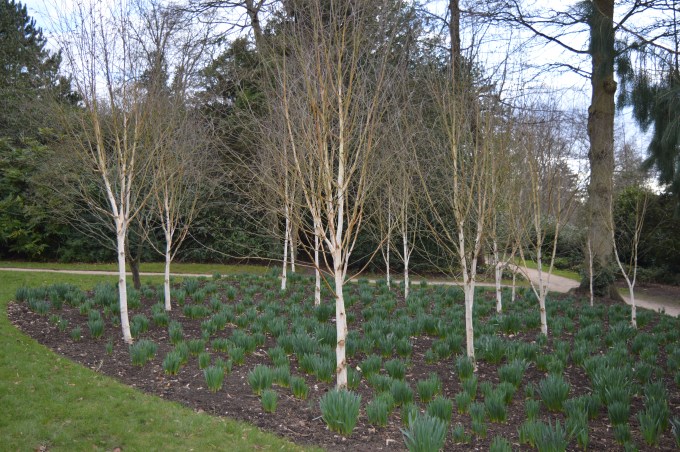
- Betula pendula at Cliveden
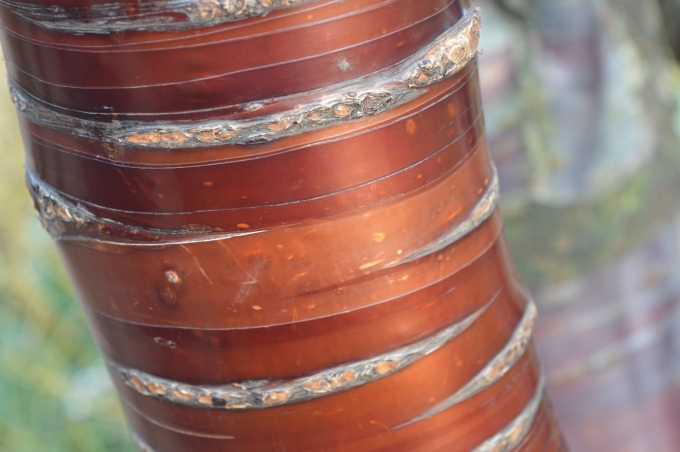
- Betula albosinensis

- Betula albosinensis
It
has an incredibly touchable bark that just begs you to peel off the
loose layers revealing the shiny new red layers beneath. It benefits
aesthetically from this as the freshly revealed layers are a bright
shiny red, id be tempted to put this close to a place where people
passing could do so.
There are several cultivars to choose from 'china rose', 'Kenneth Ashburner' are good for their colour and in my opinion one of the most showy ones is 'Red Panda'.
Hamamelis - Witch Hazel

- Hamamelis mollis
The humble witch hazel is always a worthy addition to any garden. The Genus consists of 6 plants
Hamamelis japonica
Hamamelis mexicana
Hamamelis mollis
Hamamelis ovalis
Hamamelis vernalis
Hamamelis virginiana
For our purposes though we will concentrate on Hamamelis mollis & Hamamelis ×intermedia (H. japonica × H. mollis) as they provide the showiest winter flowers. The Hamamelis Mollis was introduced by plant hunter Charles Maries, he sent it back to the Chelsea based nursery James Veitch & Sons of Chelsea, London in 1879. It took a further 23 years for its beauty to be noticed and for enough stock to be propagated for it to go on general sale in 1902.
Hamamelis ×intermedia first came into existence at the Arboretum Kalmthout a Belgium Botanical garden. Originally a tree plantation for Charles van Geert in 1857 it is now owned by Antwerp province and is open to the public.
Jelena and Robert de Belder selected cultivars that were being bred for red flowers from the hybrids. Jelena, Diane & Livia were the first introductions. Now the list and variety is almost endless!
If you want to see them in all their amazing glory there is a Nursery based in Kent Witch hazel Nursery which has open days (2017 - Sunday 22nd January 2017. 10am to 4pm
Sunday 5th February 2017. 10am to 4pm ) where you can see around 125 cultivars!
Hamamelis mexicana
Hamamelis mollis
Hamamelis ovalis
Hamamelis vernalis
Hamamelis virginiana
For our purposes though we will concentrate on Hamamelis mollis & Hamamelis ×intermedia (H. japonica × H. mollis) as they provide the showiest winter flowers. The Hamamelis Mollis was introduced by plant hunter Charles Maries, he sent it back to the Chelsea based nursery James Veitch & Sons of Chelsea, London in 1879. It took a further 23 years for its beauty to be noticed and for enough stock to be propagated for it to go on general sale in 1902.
Hamamelis ×intermedia first came into existence at the Arboretum Kalmthout a Belgium Botanical garden. Originally a tree plantation for Charles van Geert in 1857 it is now owned by Antwerp province and is open to the public.
Jelena and Robert de Belder selected cultivars that were being bred for red flowers from the hybrids. Jelena, Diane & Livia were the first introductions. Now the list and variety is almost endless!
If you want to see them in all their amazing glory there is a Nursery based in Kent Witch hazel Nursery which has open days (2017 - Sunday 22nd January 2017. 10am to 4pm
Sunday 5th February 2017. 10am to 4pm ) where you can see around 125 cultivars!
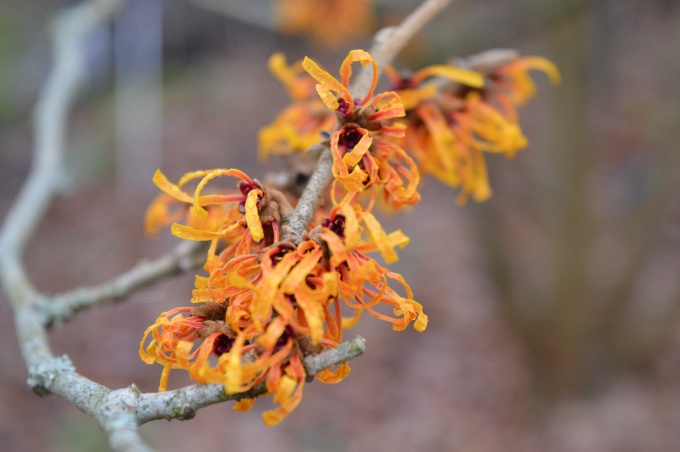
- Hamamelis 'Orange peel'
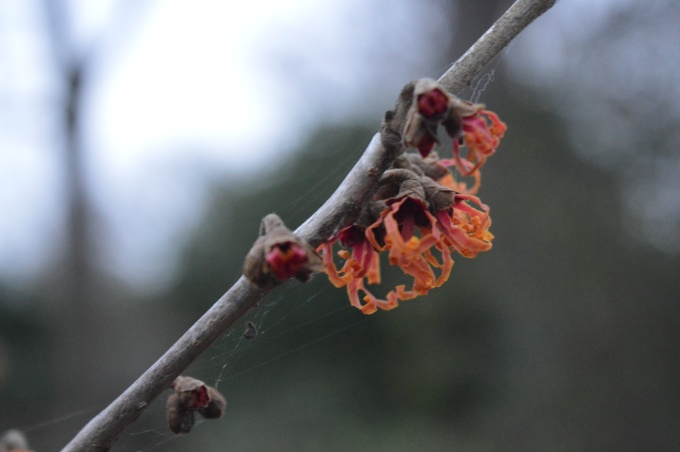
- Hamaelis 'Jelena'
If
you're looking for something that little bit different though you'll
have to look a bit further afield! I asked one of the finest rare plantsmen I know for his favourite "Winter" plant knowing that the reply wouldnt be a run of the mill answer. He didn't disappoint
Ben Probert - @BensBotanics
http://www.bensbotanics.co.uk/
Im not sure that "pug ugly" is a fair description, its actually quite pretty...The plant that really excites me is a bit of an odd one (of course!); Symplocarpus foetidus. It's not a plant that will ever set the world alight but I like it because there's a bizarre and wonderful architecture to its giant 'snail shell' spathe, although stuck at ground level its spathe is I think a nice colour, and it has the interesting element of 'thermogenesis' to keep itself warm in the bitter winters of its homeland. I lost several generations of it before I learnt the secret of getting it to survive winters here, and it flowered last year for meWinter flowers tend to be all a bit samey- little dainty flowers with a dainty scent. It's nice that there's something 'pug ugly' around too!
It is a bit of a sod to grow; it grows in boggy ground that freezes hard in winter, so in cultivation it needs lots of water in summer and then a drier winter- easier said than done. With a root system potentially 1m+ long it's a bit of a bugger in a pot too!
Symplocarpus foetidus
In part 2 of the Winter Garden I will be looking at Groundcover, climbing plants, grasses and seedheads. I'll be looking at permanent structure within a garden, this can make all the difference when planning out your garden. Also which gardens in the UK are amazing to visit for inspiration on a cold winters day. So make sure you follow to get an alert when its published!
Labels:
Botanical,
Botany,
colour,
designer,
explore,
Flowers,
garden,
gardeners,
gardening,
Horticulture,
National Trust,
plant hunter,
Plants,
pruning,
scent,
shrubs,
Sissinghurst,
trees,
winter,
winter garden
Saturday 17 December 2016
Lighting up your life!
 |
| Hart tounge Fern with bubbles - Woburn Abbey 2015 |
Last year I was lucky enough to go along to Woburn Abbeys Lumiere event. It was a bit of a que to get in and afterwards I heard a number of complaints about this but lets face it the event itself was absolutely faultless. The food put on and the exhibits, lighting etc were beautiful! The staff themselves were incredibly helpful & cheerful in the face of somewhat adverse conditions. Maybe I am in the minority in that I was in good company and sitting for a while, chatting in a nice warm car wasnt a hardship, anyway! Once we had arrived we had a wonderful experience!
 |
| Ice sculpture - Woburn Abbey 2015 |
There are a few other events of a similar nature, which whilst magical at night are somewhat lacking when viewed in the cold stark light of day. Its a one thing for a garden to have a full size Cinderella & carraige plonked on the grass and pull it off in style at night but during the day you could find yourself thinking its a bit garish & gauche.... it totally is!
 |
| Chinese New Year - Chiswick House 2016 |
How about some weird alien underwater jellyfish things? I bet at night they look amazing... but during the day? Have you ever seen an abandoned plastic bag floating down the river? Yeah, its a lot like that.
 |
| Chinese New Year - Chiswick House 2016 |
Even the "big gardens" dont always get it right when it comes to daylight viewing of these attractions im sad to say. Although in their defence I dont think its an easy task.
 |
| Kew Gardens in daylight - 2015 |
 |
| Kew Gardens in daylight - 2015 |
When viewed at night though these spaces come alive and that is the point!
 |
| Across the lake - Secret Garden Party 2016 |
 |
| In the woods - Secret Garden Party 2016 |
I hope you enjoy my latest attempts!
You can still book some tickets online (I think?) but if you're determined to go and can't find tickets online you can turn up on spec, they hold a few tickets back on the gate but it is a risk.
The trail starts with with the giant "trees" pictured above, to your left the buildings and trees are beautifully lit, to your right glimpsed through the trees the Palmhouse is lit up like a disco ball. The smell of mulled wine and roasted chestnuts is carried on the breeze luring you on into the garden. Lights flicker in the distance and excited children waving lightsabers and oscillating light fans are herded aong darkened walkways by parents & grandparents. A festive atmosphere abounds!
I seem to be in the minority as I get my camera out and try to find the best angles for the shots I want to take but then I'm used to that.
So far I haven't seen anything that in daylight might make me shudder, my lack of a tripod is somewhat lamentable though.
At least I thought...
Until I reached this...
The heart shaped glitter ball, which although at night looks pretty cool does make me wonder how cool it'll look in daylight?
The light tunnel, which very popular amongst visitors for photo opportunities, may not have the same impact when viewed in daylight.
I'll admit though it did look amazing with its flowing, pulsating display.
Next stop was an outdoor disco complete with santas elf DJ, the kids were loving the christmas themed playlist... I moved swiftly past as "So here it is merry christmas!" came blasting from the turntables...
Even the fact i was continually having to dry off my cameras lens, as you can see in the pic above, hadnt dampened my spirits entirely but at the halfway point I had found my spirits flagging slightly. The stalls selling christmassy themed beverages and snacks so far had only taken cash & like the queen *snorts* I dont tend to carry much. I've got way too used to everywhere accepting card payments! Bad planning on my part and as everything seemed to be priced at a fiver or above I was concious of my limited budget.
It was at this point I hit the Funfair portion of the trail.
Thankfully, for me, I found a catering point selling cinnamon sugared donuts covered in hot chocolate sauce and spiced apple drinks where i could for a reasonable price add a shot of rum. Suddenly I felt a lot more cheery at the prospect of another hour in the rain!
And so I tried to find the start of the second part of the trail...
I wandered round the funfair twice seeing no obvious exit other than the entrance, maybe it was just me being daft but as things had been set out in a linear fashion I had expected that to continue? Eventually I opted for leaving via a not entirely legitimate exit, I do love escaping out of a backdoor, I just couldn't face slogging my way through the crowds of people who all seemed to be moving in the opposite direction to me again!
I found myself on a completely deserted darkened path which for me was a glorious relief!
No people shoving and jostling, I took a moment to just savour the aloneness and relative quiet before heading back into the fray...
I rejoined the throngs and realised that the rain had taken a short break, I was now heading towards the Hive, which I still haven't seen in daylight.
Viewed at night with people clustered underneath its hard to realise the scale of it or to hear the constant humming noise it emits but this structure is massive. Its something that I think I would prefer to see in daylight whilst in a less crowded atmosphere. I managed to get a pic of the centre looking upwards, its times like this im reminded exactly how short I am as people elbows and backpacks tend to be about my face level providing an exciting opportunity for me to play "Lets avoid a black eye!"
Once again heading off piste, I hopped over the seating area to escape the crowds and saw the another Glasshouse in the distance, having totally lost my bearings in this darkened version of the familiar Kew I couldn't tell if it was the Princess of Wales Conservatory house or the Palmhouse? On reflection I'm going to say PofW Conservatory.
Having finished my Apple rum, delicious, I found more beautifully lit trees. I think this is without doubt my favourite part of the trail. The decorations and installations are great but personally theres a part of my mind always judging how its going to look in the cold light of day.
One of the bits I liked the most, not that strangely given my obsession with Wisterias, was the illuminated arbour covered in the now naked tendrils and convuluted vines of the Wisterias. It created a somewhat nightmarish visage which totally appealed to my surrealist dark side.
Maybe not very festive? But certainly attractive to my mind.
This led onto an opportunity to roast marshmellows... If youd come as a family group I can see how this would end up being an expensive trip out as this area was logjammed with pushchairs & small children clamouring at their parents for the chance to turn sugary delights into a gooey dripping mess. I'll say this for Kew, they know how to cater to families!... I got out quick sharp!
Another installation, this time festive candles!
By this time I was cold, wet, peopled out... not the fault of Kew. More that I was still getting over a nasty cold, so i scurried past a christmassy type play thing laid on for the kids and found another quiet spot ...
At this point I was beginning to wonder when I would reach the Palmhouse which I'd seen at the start? I was positive I had to be close as I'd been walking for close on 2 hrs now!
Seriously
2 Hours...
At that moment I emerged onto a spectacular sight!
Now please forgive my indulgence here but I got a bit excited by the photo opportunities here...
Subscribe to:
Posts (Atom)





























































